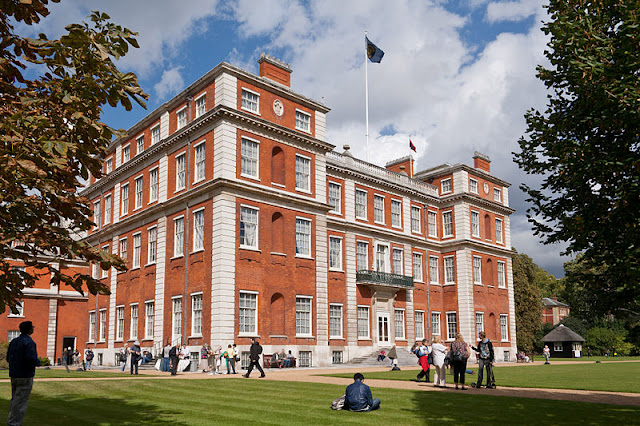 |
| Marlborough House South Side. Image from Wikimedia Commons |
Originally built in the 1700s, Marlborough House was built for Queen Anne’s favorite confidante, Sarah Churchill, Duchess of Marlborough, who wanted a house that was "strong, plain and convenient and good". In 1709, Sir Christopher Wren, one of the most revered English architects of all time, and his son were commissioned to design the Marlborough House. The brick building with rusticated stone quoins was completed in 1711. For more than a century, it served as the London residence of the Dukes of Marlborough.
Royal Residence
In 1817, Marlborough House was reacquired by the Crown. It served aa the residence of Princess Charlotte of Wales and her husband, Prince Leopold of Saxe-Coburg, the future King Leopold I of the Belgians. Unfortunately, the princess died later that year and the prince only used the house occasionally in the subsequent years.
In the 1820’s, there were plans to demolish the House to replace it with a terrace similar to that of the neighboring Carlton House Terrace. The proposal, however, did not come to fruition. In 1831, Marlborough House was given to the wife of King William IV, Queen Adelaide, following her husband’s ascent to the throne.
Following Queen Adelaide’s death in 1849, Prince Albert arranged for Marlborough House to be used by the National Art Training School, later the Royal College of Art, from 1853 to 1861. Marlborough House underwent renovations from 1861 to 1863. A deep porch and a range of rooms were added on the north side by Sir James Pennethorne especially for the future King Edward VII and his wife Princess of Wales, Alexandra of Denmark. The couple then made the house the social center of London.
 |
| Marlborough House c1850s. Image from Wikimedia Commons |
With Queen Victoria’s dull and serious court, the Prince and Princess of Wales set out to establish their own court, which became known as the Marlborough House Set. The future king welcomed all manners of people into his inner circle, for as long as they were amusing, entertaining, well-mannered, sporting, and wealthy. He shocked high society when he made friends with several wealthy Anglo-Jewish families, who had never before been welcomed into “Gentile” homes. The “Jewish element” of Marlborough House set was complemented by the prince’s wealthy American friends who were eager to marry into titles and enter London’s social circle.
 |
| Marlborough House Garden Front, c1896. Image from Wikimedia Commons |
Dowager House and Subsequent Use
Marlborough House was vacated when the Prince of Wales ascended the throne as King Edward VII. From 1910 until 1953, Marlborough House has served as a dowager house, first, for Queen Alexandra and then by Queen Mary.
Following King Edward VII’s death in 1910, Queen Alexandra, now dowager queen, returned and made Marlborough House her London home until her own death in 1925. Later, in commemoration of Alexandra, an Art Nouveau-Gothic fountain was created by Alfred Gilbert in the Marlborough Road wall of the house. Around this time, some alterations were made in the property. The main entrance gate, originally located on Pall Mall, was relocated to Marlborough Road, which passes between Marlborough House and St. James’s Palace.
After the death of George V, his widow, Queen Mary, took up residence in Marlborough House in 1936, where she lived until her death in 1953. Among the additions made by the queen included the thatched-roofed summer house and her pet cemetery, which remains to this day. In 1967, Queen Elizabeth II unveiled a plaque, which can be seen in the exterior wall closest to the corner with the Mall, to commemorate Queen Mary.
After the death of Queen Mary, Queen Elizabeth, now Queen Mother, intended to move to Marlborough House. However, it became apparent that a huge sum should be spent for refurbishment and more for the maintenance. Since Clarence House had gone through renovation for then-Princess Elizabeth and Prince Philip, it was decided that the Queen Mother would make Clarence House her London home for the remainder of her life.
In 1965, Queen Elizabeth II leased Marlborough House to the Commonwealth Secretariat, an arrangement that continues until today.
Features
Marlborough House is listed as a Grade I mansion by Historic England. It boasts of numerous priceless artworks, including battle pieces by French decorative painter Louis Laguerre. The almost cubical saloon has wall paintings of Laguerre’s Battle of Blenheim. The ceiling has a cupola enwreathed by paintings by Italian Mannerist Orazio Gentileschi. The saloon’s paired staircases also features more battle pieces by Laguerre. The interiors, nevertheless, have been altered several times. The public may visit Marlborough House during Open House Weekend every September. The house accommodates group tours upon arrangement.


.png)





0 Comments